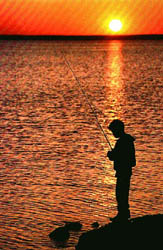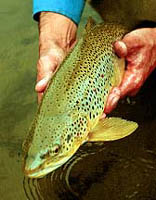Clean, cold waters require special protection
Sweeping new regulations for Alberta's Eastern Slopes
by Clive Schaupmeyer
Clean, cold snowmelt water flows out of the Rocky Mountains in Western Alberta. Before reaching the cities and towns of the Great Plains the water runs clear, is free from pollution, and carries few nutrients. Pristine water in bea
utiful country. Ideal trout water. Ideal for trout fishing.
However, the combination of low water and increased angling has reduced trout populations in some of the hundreds of creeks, streams and rivers along the "eastern slopes" of western Alberta. The trout grow slowly in these waters an
d reach breeding age later than in warmer climates on the plains and farther south. Up until this year anglers could kill up to five trout per day on many of the countless streams. Not a lot of anglers who fish in Alberta's foothills and mountains kill tr
out. However, as a result of liberal bag limits and slow growth rates, populations have declined in many streams.
 Pressure on Alberta's department of Environmental Protection forced a public review of existing angling regulations, as a result, two general changes will be in place starting
April 1, 1998. Daily catch limits will be reduced, and minimum size limits will be increased. In addition, portions of more than 30 streams will have special catch-and-release regulations - up from the handful of zero-limit streams in previous years. Pressure on Alberta's department of Environmental Protection forced a public review of existing angling regulations, as a result, two general changes will be in place starting
April 1, 1998. Daily catch limits will be reduced, and minimum size limits will be increased. In addition, portions of more than 30 streams will have special catch-and-release regulations - up from the handful of zero-limit streams in previous years.
Resident and visiting anglers will have to study the new regulations with care to make sure they are fishing legally. Fishing in a way that will protect our sportfishing for decades to come.
Daily limits have been reduced to cut down the harvest. The daily catch limit for trout and Arctic grayling (combined) will be a total of two fish per day. The limit for mountain whitefish will be five fish per day ... down from te
n. These restrictions will, of course, not apply on the new catch-and-release-only streams. Bull trout will continue to be protected throughout the province and no harvest will be permitted on all waters.
New minimum size limits will be in effect starting April 1, 1998. Until this season, general minimum sizes for trout (in flowing water) were 8 or 10 inches, depending on location. However, many species in these cold waters had not
reached breeding age by the time they were 10 or 12 inches. Therefore they were not able to add a new generation. As a result, minimum-size limits for rainbow and cutthroat trout have been increased to 10, 12 or 14 inches, depending upon the need for prot
ection, populations and growth rates. In addition to reduced bag limits for mountain whitefish (a species most thought would never require protection) a minimum-size limit of 12 inches will be in effect.
The general minimum size limit for Arctic grayling has been increased to 14 inches. Special minimum size limits of 16 inches for brown trout and 12 inches for brook trout have been adopted on a small number of streams.
 Sections of more than 30 streams and their tributaries will have zero limits (catch-and-release only) for the entire open season. Brook trout and mountain whitefish will be per
mitted in some catch-and-release streams because populations of these two species are not under pressure. Some anglers and biologists would like to reduce (or eliminate) brook trout from Alberta's streams because they are not native. Sections of more than 30 streams and their tributaries will have zero limits (catch-and-release only) for the entire open season. Brook trout and mountain whitefish will be per
mitted in some catch-and-release streams because populations of these two species are not under pressure. Some anglers and biologists would like to reduce (or eliminate) brook trout from Alberta's streams because they are not native.
Bait in streams along the Eastern Slopes will continue to be banned to reduce hooking mortality. The use of maggots (only) will be permitted between August 16 and October 31 on portions of a few larger rivers. The intent of this re
gulation is to allow some anglers to catch mountain whitefish. By restricting the bait to maggots only, fisheries biologists feel that hooking mortality will be kept to a minimum on released fish.
To facilitate the acceptance and understanding of the new regulations, four new Eastern Slopes angling zones have been designated. Each zone represents one or more specific watersheds. Within each zone, open-season dates have been
standardized to make it easier for anglers to understand. There are exceptions to open-season dates within each zone. The exceptions either give added protection to critical spawning areas or extend the fishing season to increase sportfishing opportunitie
s where they will not harm fish populations.
 Will the new regulations in my home province of Alberta work? The answer is: without a doubt. Several years ago, bait was banned in all flowing waters along the Eastern Slopes
and size limits were added. These changes have had a positive effect on trout size and numbers in many waters and the new regulations will go a long way to sustain or increase populations. My guess is that trout fishing will get better over the next few
years. I hope so, because I plan on retiring in four years. (Actually four years and three weeks, but who's counting?) Without these radical changes the increased angling pressure would surely deplete our fish populations. And I'd end being a grumpy old a
ngler. Wish us well. Wish me well. Will the new regulations in my home province of Alberta work? The answer is: without a doubt. Several years ago, bait was banned in all flowing waters along the Eastern Slopes
and size limits were added. These changes have had a positive effect on trout size and numbers in many waters and the new regulations will go a long way to sustain or increase populations. My guess is that trout fishing will get better over the next few
years. I hope so, because I plan on retiring in four years. (Actually four years and three weeks, but who's counting?) Without these radical changes the increased angling pressure would surely deplete our fish populations. And I'd end being a grumpy old a
ngler. Wish us well. Wish me well.
Note: This article was written to create awareness only and has no legal sanction. It lacks details about the dozens of new regulations that will soon be law. Anglers in Alberta are responsible for knowing the exact regulations on
the waters they fish. Consult the 1998 Alberta Guide to Sportfishing Regulations for more details. The new regulations will be out any day now.
Closing thought ... books you don't read can't help you. (And that would include the new 1998 sportfishing regulations wherever you live.)
Return to Index
Copyright ©1998 Clive Schaupmeyer
Clive Schaupmeyer is an outdoor writer and photographer. He is the author of
The Essential Guide to Fly-Fishing,
a 288-page book for novice and intermediate fly anglers. His photo of a boy
fishing was judged the best outdoor picture of 1996 published by a member of
the Outdoor Writers of Canada. He fly-fishes for trout in Alberta's foothill
and mountain streams and for pike near his home in Brooks, Alberta.
Our Man In Canada Archives
|



